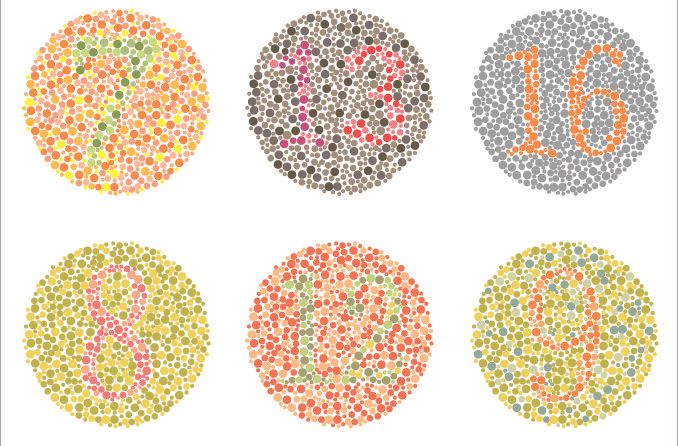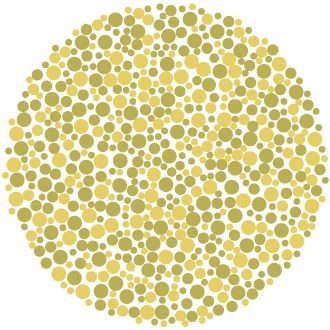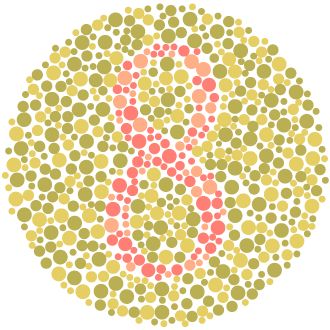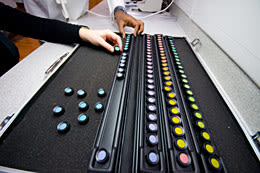Tests for colour vision defects and types of colour blindness

A colour blindness test is a device your optometrist uses to determine if you have a colour vision defect or deficiency, or what used to be known as colour blindness.
If you think you might have a colour vision defect, visit your optometrist. (Don't have one yet? Find an optometrist near you.)
There are two types of colour vision tests:
Screening tests that can detect the presence of a colour vision problem
More detailed, quantitative tests that can detect a colour vision deficiency and determine the type and severity of the colour vision defect
Screening colour vision tests
The most widely used screening test for colour vision is the Ishihara Colour Vision Test.
The test is named after Japanese ophthalmologist Shinobu Ishihara (1879-1963), who devised the procedure and first published a description of it in 1917.


Optometrists use Ishihara plates to screen patients for colour vision problems. Someone with a red-green colour deficiency may not see the red number in this example.
The Ishihara Color Vision Test consists of a booklet, each page containing a circular pattern (or "plate") comprising many dots of various colors, brightness and sizes.
The seemingly random coloured dots are arranged in such a fashion that a person with normal colour vision will see a single-digit or two-digit number within the array of dots. A person with a colour defect will either be unable to see a number or will see a different number than the one seen by a person with normal colour vision.
The complete Ishihara Colour Vision Test contains 38 plates. Abbreviated versions that contain 14 or 24 plates are more frequently used as screening tests during a comprehensive eye examination.
People being tested generally view the Ishihara plates in normal room lighting while wearing their usual prescription glasses. As the Ishihara test requires the person being screened to recognise and identify numbers, the test may be less reliable when testing the colour vision of very young children, (this can be overcome by the optometrist asking the child to trace the shape with their finger).
A term frequently used to describe the colour images in a Ishihara Colour Vision Test is "pseudoisochromatic plates." This alludes to some of the coloured dots in the pattern that may at first seem equal ("iso-") in colour ("chromatic") with surrounding dots.
This is a false ("pseudo") sameness, and the difference that exists enables a person with normal colour vision to detect the "hidden" number within the array of dots.
Since the introduction of the Ishihara Colour Vision Test, medical device companies have developed similar colour vision screening tests also using pseudoisochromatic plates.
Today there are also many colour vision apps, for example, the ColorDx computerised colour vision test (by Konan Medical) is a self-administered, self-scoring app that's available to download on tablets and computers.
In addition to testing for genetic colour vision defects, the ColorDx app can detect colour vision deficiencies that can develop later in life due to glaucoma, multiple sclerosis, diabetic retinopathy, macular oedema and other disorders, as well as colour vision problems associated with long-term use of medications and other substances, according to the company.
Quantitative colour blind tests
For a more detailed analysis of colour deficiency and/or a person's ability to accurately perceive colours, a quantitative colour vision test is needed.
The most popular such test is the Farnsworth-Munsell 100 Hue Test.

The Farnsworth Munsell 100 Hue test identifies and quantifies colour vision problems. (Image: Macular Pigment Research Group, Waterford Institute of Technology)
This test consists of four trays containing many small discs of varying hues. Each tray has a coloured reference disc at one end. The person being tested must arrange the other discs within the tray to create a continuum of gradually changing hue.
For accurate results, the Farnsworth-Munsell 100 Hue Test should be administered in a viewing booth that simulates natural daylight as closely as possible. Also, the coloured discs should be replaced at least every two years to prevent loss of colour saturation that could affect outcomes.
Each coloured disc is numbered on the bottom to enable scoring the results against a key. The closer the match between the test sequence of caps and the correct sequence, the more accurate the person's colour perception is.
In this fashion, the 100 Hue Test can detect whether or not the person being tested is colour defective and also determine the type and severity of his or her colour vision deficit.
An abbreviated version of the 100 Hue test — called the Farnsworth-Munsell D15 Test — contains only 15 numbered discs of different hues. The D15 test, like the Ishihara Colour Vision Test, is for colour vision screening purposes only, and cannot quantify the severity of a person's colour defect.
Who should take a colour vision test?
A colour vision test should be given to anyone considering a profession in which accurate colour perception is essential. Examples include electricians, commercial artists, designers, technicians, and certain manufacturing personnel.
The effect colour vision problems has on a person's job performance depends in large part on the colour-related requirements of the position and the severity of the person's colour vision deficiency.
In many cases, fears about being handicapped by poor colour vision are unwarranted. As the condition is present at birth, most colour vision defective people are unaware of their deficiency and do not find that it interferes significantly with their daily lives.
There is no treatment for colour blindness but in a few cases specially tinted contact lenses may improve a person's ability to perceive the differences between certain colours.
Online colour blind tests
Many colour blind tests can be found online. Most of these are variations of the Ishihara screening test and are presented in varying degrees of quality.
As exact colour representation is essential for the accuracy of any colour blind test, results from online colour vision screening tests are suspect. For the most accurate results, see your optometrist and take a colour vision test administered by a trained professional using standardised testing materials under proper lighting.
Page published on Tuesday, 17 March 2020






